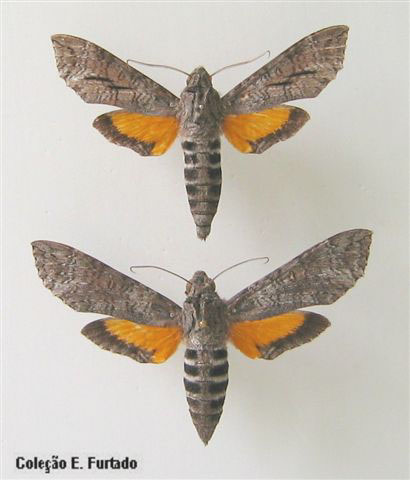Isognathus allamandae
|
|
Updated as per CATE (Venezuela; Brazil); May 14, 2011
|
Isognathus allamandae
B. P. Clark, 1920

Isognathus allamandae, Pair: male 68 mm; female 78 mm, June,
Reserva Vale da Solidão, 14o22’S 56o07’W, 450 m, Diamantino,
Mato Grosso, Brazil,
courtesy of Eurides Furtado.
This site has been created by
Bill Oehlke at oehlkew@islandtelecom.com
Comments, suggestions and/or additional information are welcomed by Bill.
TAXONOMY:
Family: Sphingidae, Latreille, 1802
Subfamily: Macroglossinae, Harris, 1839
Tribe: Dilophonotini, Burmeister, 1878
Genus: Isognathus G. Felder & R. Felder, 1862 ...........
Species: allamandae B. P. Clark, 1920
|
MIDI MUSIC
.....It's a Wonderful World.....
copyright C. Odenkirk
ON.OFF
<bgsound src="world.mid" LOOP=FOREVER>
|
DISTRIBUTION:
Isognathus allamandae
(Wing span: male: 68mm; females: 78mm),
flies in
Brazil (specimen type locality): Para, Pernambuco, Mato Grosso, Minas Gerais; to
Venezuela.
There might be populations in eastern Colombia (WO??).
Very similar to Isognathus australis, but allamande has narrower wings.
The male Forewing distal margin is dentate, convex, and obtusely angled at M3.
30 mm.
Forewing upperside more uniform in colour than in Isognathus australis; grey, with darker markings and lightly shaded with white; curved white
line running between Rs1 and M1 in Isognathus australis represented by a straighter, double grey line; black streaks running between M3 and CuA1,
and CuA1 and CuA2, both heavier than in Isognathus australis.
Yellow band along inner margin of forewing upperside more extended than in Isognathus australis.
Hindwing upperside marginal band narrower than in Isognathus australis.
Yellow basal area of hindwing underside more extended than in Isognathus australis reaching Rs; dark marginal border only 1 mm wide at hind angle (4 mm in Isognathus australis).
Female: 35 mm.
As male but black streaks running between M3 and CuA1, and CuA1 and CuA2, both absent. CATE

Isognathus allamandae male, Para, Brazil,
on my home computer only, CATE.
FLIGHT TIMES:
There are probably several flights
throughout the year. Specimens have beeen recorded for June.
ECLOSION:
Moths emerge from pupae in thin-walled cocoons
under leaf litter.
SCENTING AND MATING:
Females call in the males with a pheromone released from a gland at the tip of
the abdomen. Adults nectar at flowers, including petunia.
EGGS, LARVAE, PUPAE:
Females lay eggs on Apocynaceae including Allamanda blanchetii
and Allamanda cathartica.
Larvae pupate in cocoons spun amongst leaf litter.
Return to Sphingidae Index
Return to Dilophonotini Tribe

